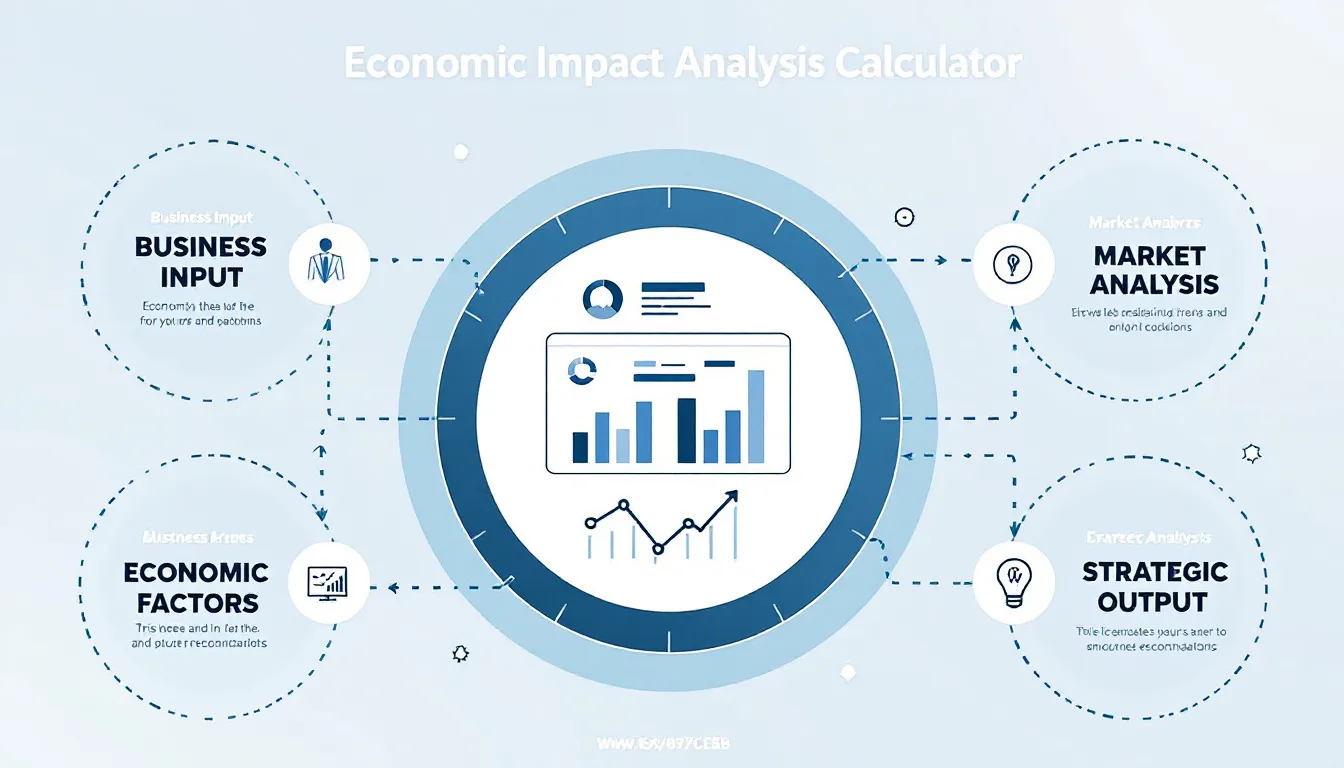Is this tool helpful?
How to Use the Economic Impact Analysis Tool Effectively
1. Business Name Field
Enter the official name of your business for accurate identification. Examples include:
- Bright Horizons Consulting LLC
- Pure Wave Renewable Energy Corp.
2. Industry Sector
Select the main industry where your business operates. Consider these examples:
- Healthcare Technology
- Renewable Energy Solutions
3. Economic Factors Analysis
Describe key economic variables impacting your business. Useful examples:
- Exchange rate volatility: 1.12 USD/EUR, Inflation expectations: 3.8%
- Consumer confidence index: 98.5, Interest rate forecast: 4.75%
4. Customer Behavior Changes
Outline recent shifts in your customers’ purchasing habits. Sample inputs include:
- Increased preference for subscription-based services, higher online shopping rates
- Delayed major purchases, growing demand for sustainable products
5. Adaptation Strategy
Explain how your business plans to respond to the economic environment. For instance:
- Introducing flexible payment options and personalized marketing campaigns
- Expanding digital service offerings and optimizing supply chain efficiency
Introduction to the Economic Impact Analysis Tool
The Economic Impact Analysis Tool enables you to assess how changing economic conditions influence your business and customer purchasing behaviors. This online analysis tool provides insights into key market trends, helping you make informed decisions and tailor your business strategies to evolving economic challenges.
By considering multiple economic indicators and customer behavior patterns, this tool offers a structured approach to predicting market reactions. Using the results, you can optimize pricing, marketing, and operational tactics that effectively respond to real-world changes.
Key Benefits
- Improve your decision-making with data-driven economic insights.
- Identify market risks and opportunities early.
- Streamline resource allocation based on predicted consumer responses.
- Stay competitive by adapting quickly to economic shifts.
Practical Usage of the Economic Impact Analysis Tool
This tool processes your input to generate a detailed economic impact analysis tailored to your business. It evaluates how different economic factors collectively affect your market, customer demand, and overall business performance.
Core Analysis Components
- Consumer Purchasing Power Index (CPPI): Measures customers’ ability to spend based on economic conditions.
- Market Elasticity Response (MER): Estimates how sensitive the market is to price and economic changes.
- Strategic Adaptation Quotient (SAQ): Assesses the effectiveness of your planned adaptation strategies.
Economic Impact Formula
The tool applies this formula to calculate your Economic Impact Score:
$$ EI = \sum_{i=1}^{n} (w_i \times f_i) \times (M_s \times C_r) $$
- EI: Economic Impact Score
- wi: Weight assigned to economic factor i
- fi: Value or effect size of economic factor i
- Ms: Market sensitivity coefficient representing market responsiveness
- Cr: Consumer response rate indicating changes in purchasing behavior
Example of Practical Application
Imagine your company faces rising interest rates and shifts in consumer preferences toward digital products. By inputting these economic factors and customer behavior changes into the tool, you receive insights adjusting your pricing strategy and prioritizing investment in digital services.
The tool might recommend:
- Increased value-based pricing to absorb higher financing costs.
- Accelerated development of online product channels.
These suggestions help your business retain customers and maintain revenue, even during economic uncertainty.
Benefits of Regular Economic Impact Analysis
1. Enhance Strategic Decision Making
- Create targeted pricing strategies based on evolving market conditions.
- Optimize inventory management to reduce overstock and shortages.
- Plan timely market entry or expansion based on consumer confidence signals.
- Focus product development on features that respond to economic trends.
2. Strengthen Risk Management
- Identify vulnerabilities in your business exposed by economic shifts.
- Predict market volatility to adjust operational plans proactively.
- Analyze consumer behavior shifts to mitigate revenue decline risks.
3. Gain Competitive Advantage
- Optimize positioning to meet changing customer demands efficiently.
- Allocate resources strategically based on economic impact insights.
- Improve customer retention with informed adaptation tactics.
Implementation Strategies for Economic Adaptation
Short-Term Adjustments
- Refine pricing based on updated cost and consumer purchasing power.
- Adjust marketing messaging to address new economic realities.
- Optimize product or service mix to meet current customer preferences.
- Modify delivery and customer engagement methods to remain competitive.
Long-Term Strategic Planning
- Adapt your business model to evolving economic landscapes.
- Diversify markets to reduce dependence on vulnerable segments.
- Build supply chain resilience to withstand disruptions.
- Invest in digital transformation to increase operational flexibility.
Frequently Asked Questions About Economic Impact Analysis
Which economic indicators are essential for my business analysis?
Focus on inflation rates, employment trends, sector-specific economic data, consumer confidence indices, and relevant macroeconomic indicators connected to your industry and customer base.
How often should I use this tool?
Conduct economic impact analyses quarterly, and additionally whenever significant changes occur in the economy or your market environment.
Is this tool suitable for small businesses?
Yes, small businesses gain valuable insights to manage resources wisely and align strategies with current economic realities.
How do I interpret the results effectively?
Review the detailed impact report focusing on the Strategic Adaptation Quotient (SAQ). Use the recommendations to prioritize initiatives that match your business capacity and goals.
Should I change my business strategy based solely on short-term data?
Balance immediate adjustments with long-term planning. Use economic insights to inform both short-term flexibility and sustainable growth strategies.
Can I analyze multiple business units with this tool?
Yes, the tool supports separate analyses for distinct business units, allowing targeted adaptations across product lines or regions.
How do I maximize the tool’s effectiveness?
Keep your economic data current, provide detailed customer profiles, and regularly monitor how your implemented strategies perform against the analysis insights.
Best Practices for Continuous Economic Analysis
Data Collection and Monitoring
- Track relevant economic indicators regularly.
- Monitor shifts in customer purchasing behavior.
- Measure market responses after strategy changes.
- Incorporate competitor and industry trends.
Strategy Execution and Review
- Implement changes in phases to manage risk.
- Assess business performance frequently against goals.
- Maintain transparent communication with stakeholders.
- Stay flexible to adjust strategies when needed.
Important Disclaimer
The calculations, results, and content provided by our tools are not guaranteed to be accurate, complete, or reliable. Users are responsible for verifying and interpreting the results. Our content and tools may contain errors, biases, or inconsistencies. Do not enter personal data, sensitive information, or personally identifiable information in our web forms or tools. Such data entry violates our terms of service and may result in unauthorized disclosure to third parties. We reserve the right to save inputs and outputs from our tools for the purposes of error debugging, bias identification, and performance improvement. External companies providing AI models used in our tools may also save and process data in accordance with their own policies. By using our tools, you consent to this data collection and processing. We reserve the right to limit the usage of our tools based on current usability factors.







